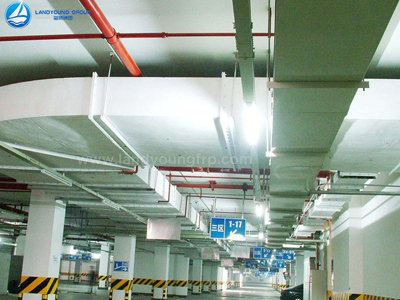sales@landyounggroup.com
+86 133 2318 2255
FRP (Fiber Reinforced Polymer) ducts, also known as fiberglass ducts, are commonly used in various industrial applications for their excellent corrosion resistance and durability. These ducts are available in a range of sizes to accommodate different airflow requirements and system designs. While there is no universal standard for FRP duct sizes, there are commonly used dimensions that are widely available in the market. Here are some standard FRP duct sizes commonly used in industrial applications:
Diameter: Round FRP ducts are available in various diameters, typically ranging from 4 inches (100 mm) to 96 inches (2400 mm) or even larger. The specific diameter required for a given application depends on factors such as airflow volume, system pressure, and space constraints.
Width: Rectangular FRP ducts come in a range of widths, starting from around 6 inches (150 mm) and going up to several feet. Common widths include 12 inches (300 mm), 18 inches (450 mm), 24 inches (600 mm), 36 inches (900 mm), and 48 inches (1200 mm). Custom widths may also be available for specific project requirements.
Height: The height of rectangular FRP ducts is typically proportionate to the width, maintaining a suitable aspect ratio to facilitate proper airflow. The height can vary depending on the width of the duct and the desired dimensions for the specific application.
Major Axis: Oval FRP ducts are often used when space limitations or specific design considerations require an alternative shape. The major axis of oval FRP ducts can range from a few inches to several feet, depending on the requirements of the system.

It's important to note that these dimensions represent common sizes, but they are not exhaustive. FRP duct manufacturers often offer a wide range of size options to meet the specific needs of different industries and applications. Additionally, custom sizes can be fabricated based on project requirements.
When selecting the appropriate FRP duct size for a particular application, it is essential to consider factors such as airflow volume, pressure drop, system design, space limitations, and any relevant industry standards or regulations. Consulting with an experienced engineer or duct system specialist is recommended to ensure the correct sizing and optimal performance of the FRP ducts.
Furthermore, it is worth noting that the standard sizes mentioned above primarily refer to the dimensions of the ducts themselves. The overall duct system may include additional components such as flanges, fittings, elbows, and transitions, which need to be appropriately sized and integrated with the ductwork for a complete and efficient installation.
In summary, FRP ducts are available in a range of sizes to accommodate different industrial applications. Round, rectangular, and oval shapes are commonly used, with varying dimensions depending on the specific requirements of the system. When selecting FRP duct sizes, it is crucial to consider airflow, pressure, space constraints, and other factors to ensure optimal performance and compliance with industry standards. Consulting with experts in duct design and engineering can help in making informed decisions regarding the selection and sizing of FRP ducts for a given application.
Contact us to discuss your FRP duct requirements. Our experienced sales team can help you identify the FRP duct options that best suit your needs.
